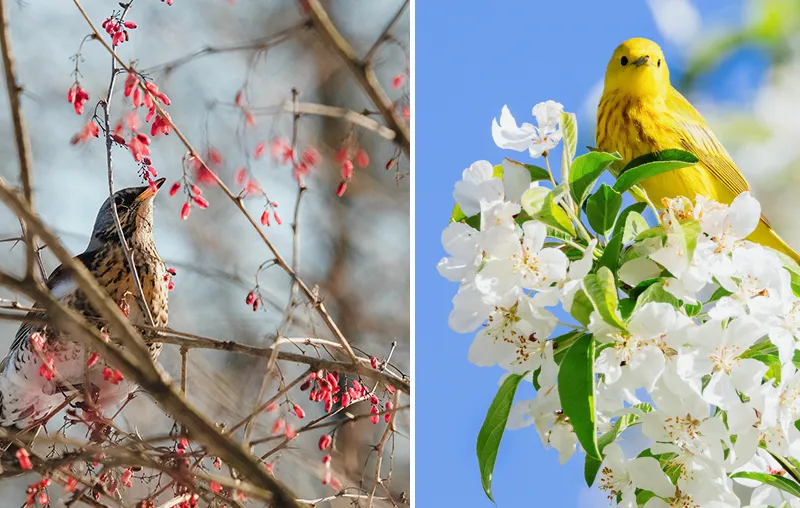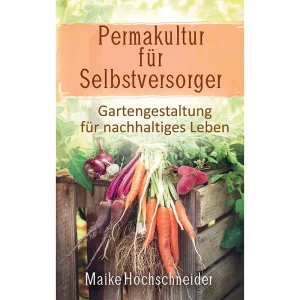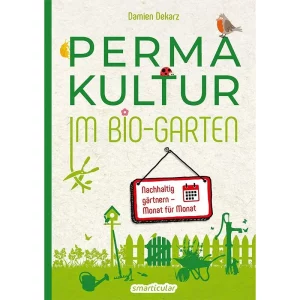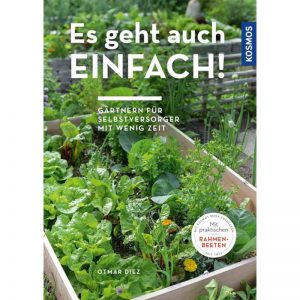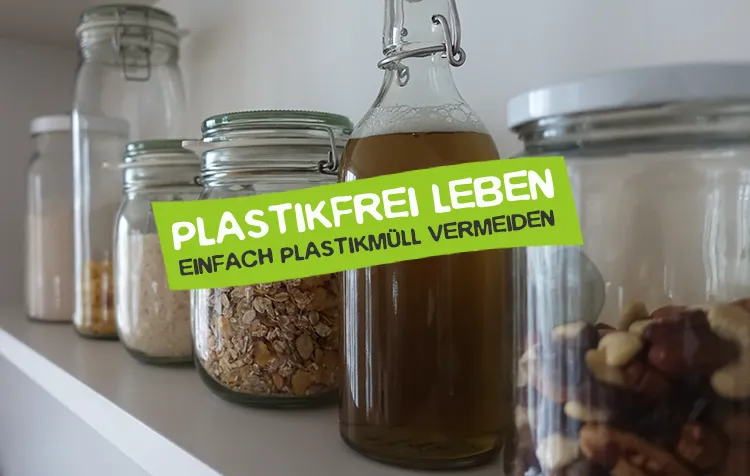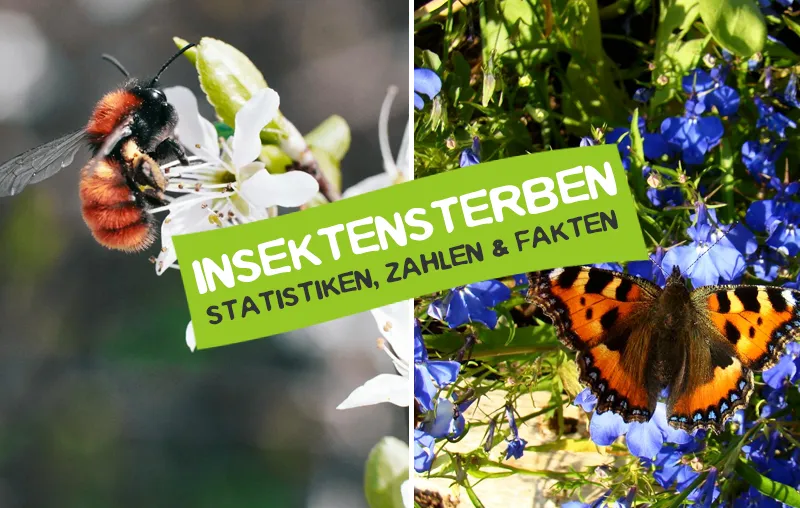Du suchst die vogelfreundlichsten Bäume? Dann bist du hier genau richtig! Wenn du einen Create bird friendly garden und künftig noch mehr Vogelgezwitscher genießen willst, ist die Wahl der richtigen Holzgewächse essentiell. Die Piepmätze ziehst du nämlich sprichwörtlich magisch an, wenn die Pflanzen ihnen sichere Nistmöglichkeiten und mit Beeren, Obst und vielen Insekten auch ein breites Nahrungsangebot servieren.
In diesem Artikel stelle ich dir jetzt die besten, heimischen Bäume und Großsträucher vor, um deinen Garten in eine Vogelschutz-Oase zu verwandeln. Außerdem gebe ich dir dann noch jeweils die wichtigsten Fakten zu den Gehölzen an die Hand. Auf geht's!
1. Vogelbeere (Sorbus aucuparia)
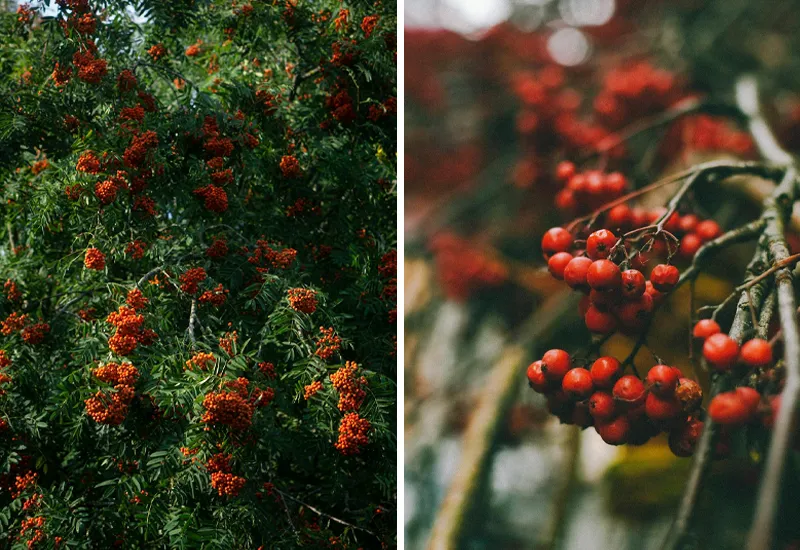
Die Vogelbeere (auch Eberesche genannt) zählt zu den wichtigsten Vogelbäumen in Deutschland. Ihre leuchtend roten Beeren sind für rund 63 heimische Vogelarten eine wichtige Nahrungsquelle, besonders während der kalten Monate, wenn das Futter knapp wird. Außerdem bietet der Baum den Vögeln Schutz und Nistmöglichkeiten – und passt auch sehr gut in kleinere Gärten.
Die Vogelbeere bekommst du im Pflanzenmarkt oder here online at the Horstmann nursery*.
Entscheidende Fakten zur Vogelbeere:
- Birds: Wichtig für rund 63 Vogelarten (u.a. Singdrossel, Amsel und Rotkehlchen)
- Maße: etwa 8-15 Meter hoch und 4-6 Meter breit
- Location: Sun to partial shade
- Other: Auch sehr gut für Wildbienen und andere Insekten
Important: Die Vogelbeere ist auch eine wundervolle Alternative für nicht-heimische, invasive Baumarten, die lokale Bäume verdrängen. Dazu zählen zum Beispiel der Essig-Baum oder die Spätblühende Traubenkirsche. Auf welche gebietsfremden Bäume du im Garten sonst noch verzichten solltest, erfährst du im verlinkten Blogartikel.
2. Vogelkirsche (Prunus avium)
Wichtig für die Biodiversity und die Vögel im Garten ist auch die Vogelkirsche (oft auch Süßkirsche genannt), da ihre roten Kirschen ihnen Nahrung bieten und ihre Blüten unzählige Raupen, Schwebfliegen und Käfer anlocken.
Die dichten Äste machen den in ganz Deutschland verbreiteten heimischen Baum umso mehr zu einem wichtigen Vogelschutzgehölz.
Du findest die Vogelkirsche im Pflanzenmarkt oder here online at the Horstmann nursery*.
Entscheidende Fakten zur Vogelkirsche:
- Birds: Wichtig für rund 48 Vogelarten (u.a. Star, Kernbeißer und Misteldrossel)
- Maße: etwa 15-20 Meter hoch und 7-12 Meter breit
- Location: Sun to partial shade
- Other: Ebenfalls für Wildbienen und andere Insekten wichtig
3. Zweigriffeliger Weißdorn (Crataegus laevigata)
Der zweigriffelige Weißdorn ist ein einheimischer Strauch oder Baum und bekannt für seine dichten, dornigen Äste, die Vögeln hervorragenden Schutz vor Katzen und anderen Raubtieren bieten. Außerdem dienen seine Steinfrüchte im Winter als ersehntes Vogelfutter. Über den Sommer lockt er viele Insekten an, die ebenfalls von Vögeln gefressen werden.
Da der vogelfreundliche Baum nicht ganz so hoch wird, ist er auch sehr gut für eine Wildhecke oder generell für kleinere Gärten geeignet.
Den zweigriffeligen Weißdorn findest du in gut ausgestatteten Pflanzencentern oder auch here online at the Horstmann nursery*.
Entscheidende Fakten zum zweigriffeligen Weißdorn:
- Birds: Wichtig für rund 32 Vogelarten (u.a. Grünfink, Haussperling und Rotkehlchen)
- Maße: etwa 3-5 Meter hoch und 2-3 Meter breit
- Location: Sun to partial shade
- Other: Extrem insekten- und vor allem bienenfreundlich
Good to know: Es gibt auch noch den eingriffeligen Weißdorn (Crataegus monogyna), der einen ähnlichen, ökologischen Wert besitzt und ebenfalls zu den vogelfreundlichen Bäumen zählt.
4. Kornelkirsche (Cornus mas)
Auch die frühe Blüte der Kornelkirsche lockt Insekten an, die wiederum Vögel anziehen. Und ihre robusten Früchte dienen im Herbst Vögeln und einigen Säugetieren als Nahrung.
Doch die Kornelkische ist nicht nur ein großartiges Vogelnährgehölz. Das aufstrebende Astwerk des vogelfreundlichen Baums dient den Vögeln auch als Nist- und Landeplatz.
Du findest die Kornelkirsche hier bei der Baumschule Horstmann* oder alternativ im Pflanzenhandel vor Ort.
Entscheidende Fakten zur Kornelkirsche:
- Birds: Wichtig für etwa 15 Vogelarten (u.a. Dompfaff, Kernbeißer und Eichelhäher)
- Maße: etwa 2-6 Meter hoch und 3-5 Meter breit
- Location: Sonne bis Schatten
- Other: Auch Haselmäuse und Siebenschläfer mögen die Früchte
5. Gewöhnlicher Wacholder (Juniperus communis)
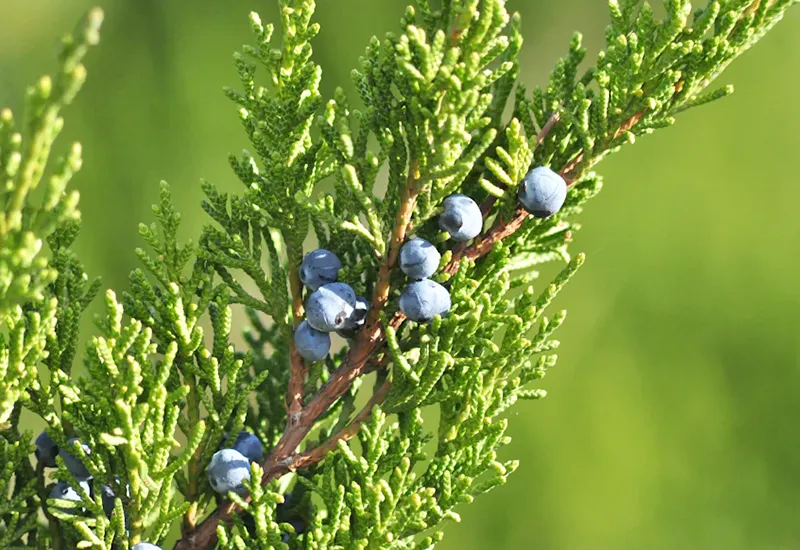
Du willst den Vogelschutz fördern und das Stop global species extinction? Dann sollte der gewöhnliche Wacholder (oft auch Gemeiner Wacholder genannt) unbedingt zu den Gehölzen in deinem Garten zählen! Die nahrhaften Wacholderbeeren des Nadelbaums bieten nämlich zahlreichen in Deutschland heimischen Vögeln eine wichtige Nahrungsquelle.
Seine dichten Zweige stellen zudem Schutz und eine sichere Brutstätte dar. Da der Wacholder zwar recht hoch aber nur bis zu einem Meter breit wird, passt er zudem sehr gut in die Ecken im Garten, in denen eigentlich nicht mehr so viel Platz für einen großen Baum ist.
Du findest den gewöhnlichen Wacholder in jedem gut sortieren Pflanzencenter.
Entscheidende Fakten zum gewöhnlichen Wacholder:
- Birds: Wichtig für rund 43 Vogelarten (u.a. Amsel, Krähe und Wachtel)
- Maße: etwa 4-5 Meter hoch und 1 Meter breit
- Location: Sun to partial shade
- Other: Auch Eichhörnchen und einige Insekten erfreuen sich daran
Tip: How you Eichhörnchen in deinen Garten lockst, erläutere ich dir noch einmal ganz genau im verlinkten Blogartikel.
6. Feldahorn (Acer campestre)
Sicherlich kennst du den Feldahorn (auch Maßholder genannt) bereits. Er ist ein in Deutschland einheimischer und weit verbreiteter Baum. Sein Astwerk und seine Samen machen ihn zu einem wertvollen Vogelschutz- und Nistgehölz. Er ist zudem eine wunderbare Insektenpflanze und bietet den Vögel ganzjährigen Schutz vor Fressfeinden.
Den Feldahorn bekommst du im Pflanzenhandel oder hier online in bei der Baumschule Horstmann*.
Entscheidende Fakten zum Feldahorn:
- Birds: Wichtig für etwa 15 Vogelarten (u.a. Finken, Meisen und Kleiber)
- Maße: etwa 5-15 Meter hoch und 5-10 Meter breit
- Location: Sun to partial shade
- Other: Blätter dienen auch vielen Schmetterlings-Raupen als Futter
Alternative: Da der Feldahorn recht groß werden kann, stellt der Kegel-Ahorn (Acer campestre) eine mögliche Alternative für Hobbygärtner:innen mit eher kleinerem Garten dar.
7. Speierling (Sorbus domestica)
Der Speierling ist eine ganz alte Obstbaumsorte, die vielen Menschen gar nicht so bekannt ist. Vögel schätzen seine (auch für uns Menschen essbaren) Früchte aber umso mehr, weshalb er in dieser Liste der vogelfreundlichen Bäume nicht fehlen darf.
Besonders im Herbst, wenn das „Buffet“ der Natur nicht so reich gedeckt ist, werden sie dringend gebraucht. Die ausladende Baumkrone des Speierlings bietet den gefiederten Gartenbewohnern außerdem viel Platz zum Verstecken und Nisten.
Den Speierling gibt's hier bei der Baumschule Horstmann* oder im Fachhandel vor Ort.
Entscheidende Fakten zur Speierling:
- Birds: Wichtig für viele Vogelarten (u.a. Drossel und Amsel)
- Maße: etwa 3-15 Meter hoch und 8-10 Meter breit
- Location: Sonne bis Halbschatten (viel Licht und Platz einplanen!)
- Other: Ein seltener Gartenbaum mit großem Wert für Wildbienen
Important: Wenn du an deinem Haus große Glasflächen hast, ist die Gefahr groß, dass die Vögel damit kollidieren. Damit ein möglicher Aufprall nicht tödlich endet, ist es ratsam, die Bäume etwas dichter am Haus einzupflanzen. Weitere Tipps für wirkungsvollen Vogelschutz am Fenster bekommst du im verlinkten Blogbeitrag.
8. Schlehe (Prunus spinosa)
Die Schlehe ist ein heimischer und wunderschön blühender Strauch – und für mich so etwas wie ein Alleskönner unter den Gehölzen, der definitiv in jeden Garten gehört.
Nicht nur, weil er durch seine Fruits eine wichtige Nahrungsquelle für viele Vögel darstellt, weil seine Dornen ihnen Schutz vor Fressfeinden bieten oder weil seine Äste gern als Nist- und Landeplatz genutzt werden. Nein. Auch, weil die Schlehe zu den wertvollsten Wildbienen- und Insektenpflanzen überhaupt zählt – und damit noch einmal umso anziehender für Vögel wird.
Du bekommst die Schlehe here online at the Horstmann nursery* oder im Gartencenter vor Ort.
- Birds: Wichtig für etwa 20 Vogelarten (u.a. Meise, Grasmücke und Neuntöter)
- Maße: ca. 2-4 Meter hoch und 2-4 Meter breit
- Location: Sun to partial shade
- Other: Extrem wertvoll für unzählige Wildbienen, Raupen, Fliegen und Käfer
9. rowan (Sorbus aria)
Mit der Mehlbeere pflanzt du einen wunderschönen Laubbaum und ein echtes Vogelschutz- und Vogelnährgehölz in deinen Garten.
Das dichte Laubwerk der Mehlbeere bietet ihnen sowohl Schutz-, als auch Nistmöglichkeiten. Ihre roten Fruits sind vor allem in der kalten Jahreszeit eine dringend benötigte Nahrungsquelle für viele, heimische Vögel. Dass ihre Blüten im Mai und Juni eine Vielzahl von Insekten anlocken, macht den Baum für Vögel sogar noch interessanter.
Ich habe meine Mehlbeere hier bei der Baumschule Horstmann* bestellt. Mit etwas Glück findest du sie aber auch im Pflanzenhandel bei dir vor Ort.
- Birds: Wichtig für etwa 18 Vogelarten (u.a. Mönchsgrasmücke und Eichelhäher)
- Maße: etwa 4-15 Meter hoch und 4-7 Meter breit
- Location: Sun to partial shade
- Other: Wertvolles Gehölz für viele Wildbienen
10. Wildbirne (Pyrus pyraster)
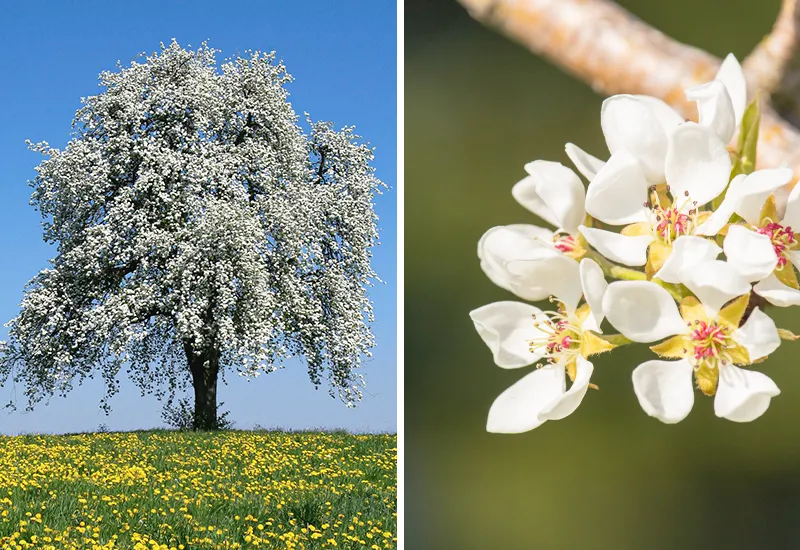
Die heimische Wildbirne trägt im Herbst essbare Früchte, die uns Menschen, aber natürlich auch vielen Vögeln, als Nahrung dienen. Da die wunderschöne, weiße Blütenpracht des Laubbaums Bienen und andere Insekten anlockt, zählt er definitiv auch zu den wichtigsten Vogelbäumen im Garten.
Der Wildbaum bietet den gefiederten Tieren außerdem Schutz und wird deshalb auch gern als Brutplatz genutzt. Ein absolutes Highlight in jedem vogelfreundlichen Garten.
Die Wildbirne bekommst du in jedem gut ausgestatteten Pflanzencenter.
- Birds: Wichtig für 24 Vogelarten (u.a. Amsel, Star und Seidenschwanz)
- Maße: etwa 5-15 Meter hoch und 5-10 Meter breit
- Location: Sun
- Other: Sehr wildbienenfreundlich; auch Siebenschläfer und Igel lieben sie
Good to know: Die Kulturbirne (Pyrus communis) ist im Gegensatz zur Wildbirne ein sogenannter Neophyt, also ein eingeschleppter, ursprünglich nicht in Deutschland heimischer Baum. Dennoch ist auch sie wertvoll für viele Vögel und Insekten.
Die besten Bäume für Vögel im Garten pflanzen und deinen Beitrag leisten!
Es ist echt einfach, deinen Garten Schritt für Schritt in einen Zufluchtsort für Vögel zu verwandeln. Hier und heute hast du die vogelfreundlichsten Bäume und Sträucher dafür kennengelernt. Beginne einfach langsam damit, einige dieser Pflanzen auf deinem Grundstück einzupflanzen und beobachte, wie sich die Vogelvielfalt vor deinen Augen entfaltet.
Ich will nicht unerwähnt lassen, dass es natürlich noch einige weitere, wertvolle Vogelschutz- und Vogelnährgehölze gibt. Mir fallen da zum Beispiel noch der Schwarze Holunder (Sambucus nigra), the Sanddorn (Hippophae rhamnoides), die Hasel (Corylus avellana), die German oak (Quercus robur) und die Common rock pear (Amelanchier ovalis) ein. Und allesamt kannst du sie dann ja auch noch sinnvoll um vogelfreundliche Stauden und Rosenhecken ergänzen.
"Adopt the pace of nature: her secret is patience."
Ralph Waldo Emerson (more at Garden Quotes)
Ich hoffe, dass ich dir mit diesem Artikel dazu inspirieren konnte, bewusst vogelfreundliche Bäume im Garten zu pflanzen, um dem sinkenden Bestand der Vögel in Deutschland entgegenzuwirken. Hast du Fragen, Anregungen oder eigene Vorschläge für wertvolle Gehölze, die du teilen möchtest? Dann freue ich mich auf deinen Kommentar.
Bleib vogelfreundlich und naturverbunden,

PS: Was tun, wenn man einen verletzten Vogel gefunden hat? Die Antwort flattert dir im verlinkten Blogartikel zu. Schau unbedingt mal rein, wenn du in so einer tierischen Notsituation vorbereitet sein und dem angeschlagenen Vögelchen helfen willst.

